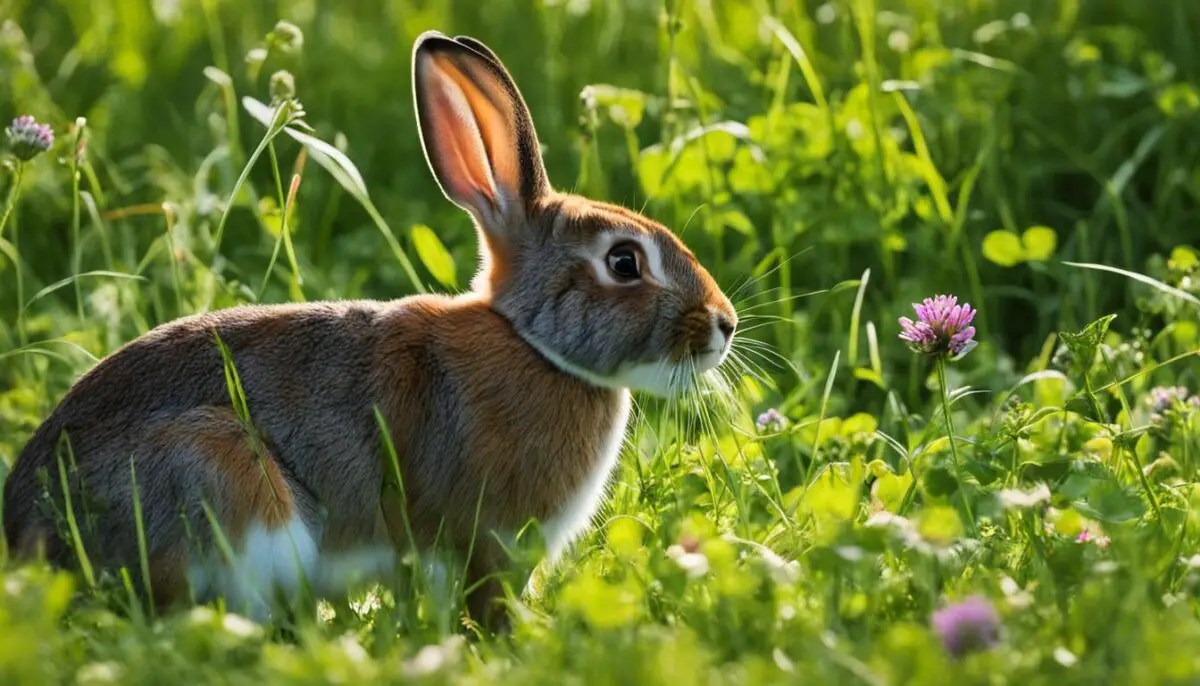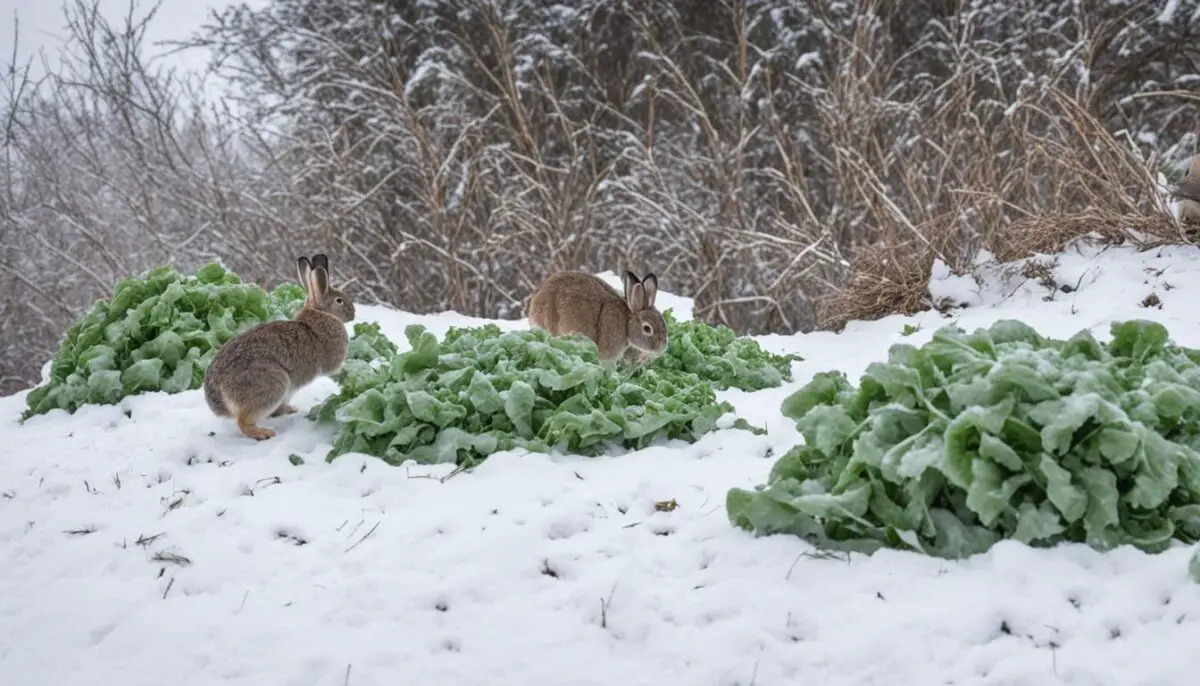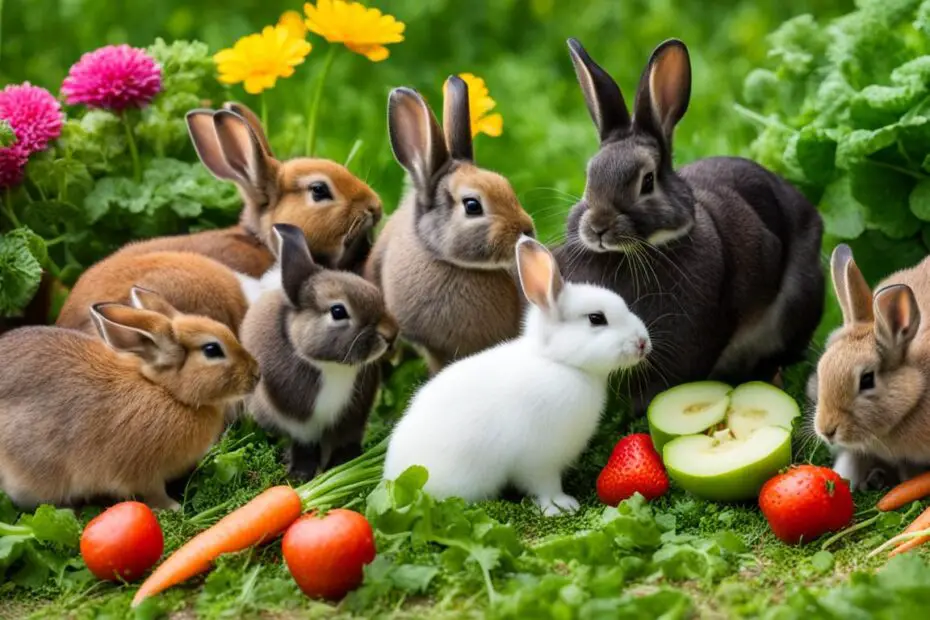Are you curious about what to feed wild rabbits? Providing the best diet for wild rabbits is essential for their health and well-being. While wild rabbits are natural foragers, it’s important to understand the types of foods that are suitable for their diet. In this article, we will explore the best foods to feed wild rabbits and share helpful tips to ensure they receive a healthy diet.
Key Takeaways:
- Wild rabbits have a varied diet that consists of grasses, weeds, bark, twigs, flowers, and herbs.
- During the winter months, when food resources are scarce, it is important to create a habitat that supports their natural foraging instincts.
- Planting shrubs and greenery that can withstand winter conditions can provide resources for wild rabbits.
- It is important to avoid making wild rabbits dependent on humans for food.
- Feeding them natural foods that promote their natural foraging behavior is ideal.
Natural Diet for Wild Rabbits
Wild rabbits have a digestive system that can handle a wide variety of plants, allowing them to enjoy a balanced diet throughout the year. Their natural diet consists of:
- Grasses such as wheatgrass, meadow grass, fescue, and bluegrass
- Weeds like dandelion, clover, and chickweed
- Bark and twigs from trees and shrubs like willow, apple, raspberry, and birch
- Flowers such as roses, daisies, and lavender
- Herbs like mint, parsley, and thyme
It’s important to note that while most plants and flowers are safe for rabbits to consume, some can be toxic and should be avoided. Rabbits have an instinctive ability to identify safe plants, but as responsible caretakers, it is our duty to create a safe and nurturing environment for wild rabbits.

“A wild rabbit’s natural diet is rich in nutrition and offers a variety of foraging options. By replicating their natural environment, we can promote their overall health and well-being.” – Dr. Olivia Bennett, Wildlife Biologist
By allowing wild rabbits to forage for their food, we provide them with exercise, mental stimulation, and a nutritionally balanced diet. It’s crucial to maintain a habitat that offers a wide range of plant species to support their natural instincts.
Ensuring Balanced Nutrition
Wild rabbits consume a diverse range of vegetation, which ensures they receive the essential nutrients necessary for their survival. This varied diet helps them maintain optimal health and prevents nutritional deficiencies.
Foraging provides wild rabbits with the following key nutrients:
| Nutrient | Benefits |
|---|---|
| Fiber | Aids digestion and maintains gut health |
| Vitamins | Supports the immune system and overall vitality |
| Minerals | Essential for healthy bones, teeth, and organ function |
| Phytonutrients | Antioxidants that protect against cellular damage and promote well-being |
By mimicking their natural diet, we ensure that wild rabbits receive the necessary balanced nutrition.
Next, we’ll explore how to provide for wild rabbits during the winter months when food resources may be limited.
Winter Feeding for Wild Rabbits
In the winter, when plant life is scarce, wild rabbits face the challenge of finding enough food to survive. During this time, they rely on alternative resources to sustain themselves. These include bark, twigs, and evergreen and pine needles from trees and shrubs in their habitat.
However, it’s important to note that finding enough food can still be difficult for wild rabbits in winter. To support their well-being, it is crucial to create habitats that provide these essential resources.
One way to encourage food availability for wild rabbits during the colder months is by planting shrubs and trees that maintain their foliage throughout winter. These plants offer a source of sustenance when other food options are limited. Additionally, leaving some grasses and weeds partially uncut in the rabbits’ surroundings can also provide food sources.
Winter Feeding Tips for Wild Rabbits:
- Plant shrubs and trees that retain their foliage during winter.
- Leave some grasses and weeds partially uncut to provide alternative food sources.
- Ensure the habitat has resources such as bark, twigs, and evergreen and pine needles.
- Do not rely solely on providing human food for wild rabbits in winter.
- Consult with wildlife experts or local conservation organizations for specific guidance based on the region.
By following these tips, you can help ensure wild rabbits have access to the appropriate diet and resources they need to survive during the winter months.

Feeding Tips for Wild Rabbits
When it comes to feeding wild rabbits, it is crucial to understand their natural behavior and dietary needs. Providing them with the right foods in a way that encourages their natural foraging instincts is essential for their health and well-being. Here are some helpful tips:
1. Offer Natural Food Options
Wild rabbits thrive on a diet of fresh and natural foods. Instead of relying solely on human-provided foods, encourage their foraging behavior by scattering vegetable scraps from your cooking, leftover leafy greens, and herbs in your yard. This allows them to discover and nibble on different food sources, mimicking their natural feeding habits. Incorporating hay or dried grass into their diet is especially important during the winter months when fresh grass is less available.
2. Choose High-Quality Commercial Rabbit Food
While it is best to prioritize natural foods, you can supplement a wild rabbit’s diet with commercial dry rabbit food. However, it is important to choose high-quality brands that do not contain added sugars or colorful bits. These additives can be harmful to their digestive system and overall health. Always read the ingredient list and opt for reputable brands that prioritize nutrition.
3. Avoid Harmful Foods
Some foods can be toxic to wild rabbits and should be strictly avoided. Potatoes, tomato vines, onions, corn, beans, nuts, and avocados should never be fed to wild rabbits, as they can cause digestive issues and other health complications. It is essential to be cautious and knowledgeable about the foods that are safe for them to consume.
4. Consider Other Wildlife
When feeding wild rabbits, it is important to consider the needs of other wildlife in your area. Opt for feeding methods that minimize the attraction of predators to your yard, as this can put the rabbits and other animals at risk. For example, avoid placing food in open spaces or near hiding spots for predators. By being mindful of the entire ecosystem, you can help create a safe and balanced environment for all wildlife.
By following these feeding tips, you can ensure that wild rabbits receive the nutrition they need while preserving their natural behaviors and instincts.
| Safe Foods for Wild Rabbits | Dangerous Foods to Avoid |
|---|---|
|
|
Remember, each wild rabbit has its own unique preferences and dietary needs, so it’s important to observe their behavior and adjust their diet accordingly. By providing a variety of safe and nutritious food options, you can contribute to the well-being of wild rabbits and enjoy their presence in your surroundings.
Conclusion
Feeding wild rabbits can be a rewarding experience, but it is essential to approach it responsibly and sustainably. By creating a habitat that supports their natural foraging instincts and offering a variety of safe and nutritious foods, you can contribute to the health and well-being of wild rabbits. It is crucial to avoid making them reliant on human food sources and to consider the needs of other wildlife when feeding them.
To summarize the feeding tips for wild rabbits, make sure to scatter vegetable scraps, leftover leafy greens, and herbs in your yard to encourage their natural foraging behavior. In addition, provide hay or dried grass, especially during the winter months when fresh grass is scarce. If you choose to use commercial dry rabbit food, select high-quality brands without added sugars or colorful bits.
Remember to avoid feeding wild rabbits harmful foods such as potato, tomato vines, onions, corn, beans, nuts, and avocado, as these can disrupt their digestion. Furthermore, be mindful of the feeding needs of other wildlife and use feeding methods that minimize the attraction of predators to your yard. By following these guidelines, you can contribute to the conservation efforts for wild rabbit populations while enjoying the beauty of these animals in your own backyard.
FAQ
What should I feed wild rabbits?
Wild rabbits have a varied diet consisting of grasses, weeds, bark, twigs, flowers, and herbs. They can also eat fruits and vegetables in moderation. To provide nutritious options, create a habitat that supports their natural foraging instincts and plant shrubs and greenery that can withstand winter conditions.
What is the natural diet of wild rabbits?
Wild rabbits primarily eat grasses such as wheatgrass, meadow grass, fescue, and bluegrass, as well as weeds like dandelion, clover, and chickweed. They also consume bark and twigs from trees and shrubs like willow, apple, raspberry, and birch. Flowers such as roses, daisies, and lavender, and herbs like mint, parsley, and thyme are also part of their diet.
What do wild rabbits eat in the winter?
During winter, wild rabbits rely on resources such as bark, twigs, and evergreen and pine needles from trees and shrubs for their sustenance. Planting shrubs and trees that maintain their foliage during winter and leaving grasses and weeds partially uncut can help provide food sources for wild rabbits during colder months.
How can I feed wild rabbits without making them dependent on humans?
It is important to avoid making wild rabbits too reliant on human food sources. Scatter vegetable scraps, leftover leafy greens, and herbs in your yard to provide additional food options. Hay or dried grass can also be provided, especially when fresh grass is scarce. Avoid feeding foods that can be harmful to their digestion, such as potato, tomato vines, onions, corn, beans, nuts, and avocado.
What are some feeding tips for wild rabbits?
When feeding wild rabbits, consider the feeding needs of other wildlife and use feeding methods that minimize the attraction of predators to your yard. Choose high-quality commercial dry rabbit food if needed and avoid brands with added sugars or colorful bits. Always ensure a variety of safe and nutritious foods and provide a habitat that supports their natural foraging behavior.


